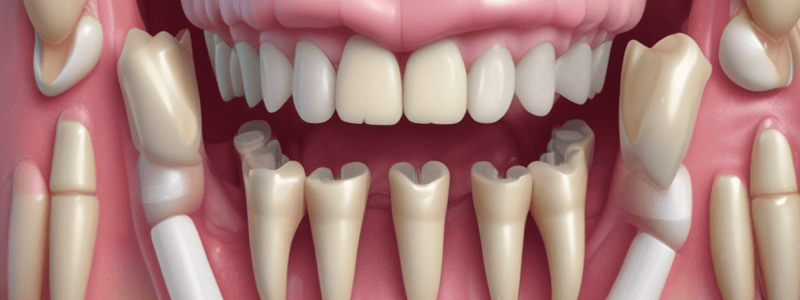Podcast
Questions and Answers
What is the primary focus of the Plaque Index (PI) assessment?
What is the primary focus of the Plaque Index (PI) assessment?
- Oral hygiene habits
- Tooth decay presence
- Gingivitis severity
- Thickness of plaque at the gingival area (correct)
What is used in the scoring of the Plaque Index (PI)?
What is used in the scoring of the Plaque Index (PI)?
- X-ray machine and dental chairs
- Toothbrush and toothpaste
- Dental floss and interdental brushes
- Mouth mirror, light source, dental explorer, and air drying (correct)
What is the score criteria for '0' in the Plaque Index (PI)?
What is the score criteria for '0' in the Plaque Index (PI)?
- A film of plaque adhering to the free gingival margin
- Moderate accumulation of soft deposits
- No plaque in the gingival area (correct)
- Abundance of soft matter within the gingival pocket
Who developed the Plaque Index (PI)?
Who developed the Plaque Index (PI)?
What is examined in the Plaque Index (PI) scoring?
What is examined in the Plaque Index (PI) scoring?
What is the minimum amount of plaque required to score '1' in the Plaque Index (PI)?
What is the minimum amount of plaque required to score '1' in the Plaque Index (PI)?
What is the definition of epidemiology according to John M. Last?
What is the definition of epidemiology according to John M. Last?
What is the main aim of epidemiology according to the International Epidemiological Association?
What is the main aim of epidemiology according to the International Epidemiological Association?
What is one of the uses of epidemiology according to Morris?
What is one of the uses of epidemiology according to Morris?
What is descriptive epidemiology used for?
What is descriptive epidemiology used for?
What is analytical epidemiology used for?
What is analytical epidemiology used for?
What is experimental epidemiology used for?
What is experimental epidemiology used for?
What is the third aim of epidemiology according to the International Epidemiological Association?
What is the third aim of epidemiology according to the International Epidemiological Association?
What is one of the uses of epidemiology according to Morris?
What is one of the uses of epidemiology according to Morris?
What is the term used to describe studies that are also known as observational studies?
What is the term used to describe studies that are also known as observational studies?
What is an index, according to AL Russell's definition?
What is an index, according to AL Russell's definition?
What is the purpose of indices in clinical observations?
What is the purpose of indices in clinical observations?
What type of index measures conditions that can be changed?
What type of index measures conditions that can be changed?
What is an example of a full mouth index?
What is an example of a full mouth index?
What is the purpose of the Gingival index?
What is the purpose of the Gingival index?
What is the score for normal gingiva in the Gingival index?
What is the score for normal gingiva in the Gingival index?
Who developed the Gingival index?
Who developed the Gingival index?
Flashcards are hidden until you start studying
Study Notes
Plaque Index (PI)
- Assesses the thickness of plaque at the gingival area of the tooth
- Method: Evaluates the entire dentition or selected teeth, examining four gingival areas (distofacial, facial, mesiofacial, and lingual surfaces)
- Uses mouth mirror, light source, dental explorer, and air drying of teeth and gingiva
- Developed by Silness & Loe in 1964
Plaque Index Scoring Criteria
- 0: No plaque in the gingival area
- 1: A film of plaque adhering to the free gingival margin and adjacent area of the tooth
- 2: Moderate accumulation of soft deposits within the gingival pocket and on the gingival margin and/or adjacent tooth surface
- 3: Abundance of soft matter within the gingival pocket and/or on the gingival margin and adjacent tooth surface
Epidemiology of Gingival and Periodontal Diseases
- Definition: Study of the distribution and determinants of health-related states or events in specified populations and the application of this study to the control of health problems (John M. Last, 1988)
- Aims of Epidemiology:
- Describe the size and distribution of disease problems in human populations
- Provide data essential for planning, implementation, and evaluation of health services
- Identify etiological factors in the pathogenesis of disease
Uses of Epidemiology
- Study historically, the rise and fall of disease in the population
- Community diagnosis
- Planning and evaluation
- Evaluation of individuals' risks and chances
- Syndrome identification
- Completing the natural history of disease
- Searching for causes and risk factors
Epidemiological Methods
- Descriptive Epidemiology: Observes and documents the occurrence, progression, and distribution of a disease or condition in a population
- Analytical Epidemiology: Investigates hypotheses derived from descriptive epidemiologic studies or other data sources
- Experimental Epidemiology: Tests hypotheses by introducing a preventive or therapeutic agent and comparing outcomes in test subjects with concurrent observations in control groups
Indices
- Definition: Numerical value describing the relative status of a population on a graduated scale with definite upper and lower limits (AL Russell)
- Methods that express clinical observations in numerical values
- Indices can be classified into:
- Reversible and irreversible indices
- Full mouth and simplified indices
- Disease, treatment, and symptom indices
Gingival Index
- Criteria: Developed by H Loe and J Silness in 1963
- Scoring Criteria:
- 0: Normal gingiva
- 1: Mild inflammation: Slight change in color and slight edema, no bleeding on probing
- 2: Moderate inflammation: Redness, edema, and glazing, bleeding on probing
- 3: Severe inflammation: Marked redness, edema, and ulceration, tendency towards spontaneous bleeding
Studying That Suits You
Use AI to generate personalized quizzes and flashcards to suit your learning preferences.




